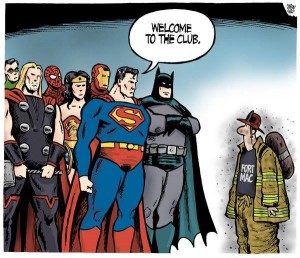Everyday heroes
I eagerly shared this image on social media this week, because it is so true.

In the weeks that follow, I suspect we should add insurance adjusters to the club as well. Adjusters we know have been at the evacuation camps since the beginning. In addition, most insurance companies are assembling their larger catastrophe or ‘cat’ teams to be ready to enter as soon as officials allow them in. But if the firefighters saved ~90% of the buildings, there will be fewer insurance claims, right? Well, not exactly.
My guess is there will be just as many claims – literally one for every building in the evacuation zone – but 90% of them will be a lot smaller than they could have been. That is good news for all who pay insurance premiums in Alberta as a much larger loss would have greatly increased the likelihood – or the amount by which — all property insurance premiums in the province would need to be raised. So the firefighters are indeed heroes and the fact that they saved as much as they did will save us all in the long run.
But don’t for a moment think that returning evacuees face a turnkey operation – they will not simply drive into town, unlock the door of their house or business, and have life immediately return to normal. Each and every one of those 30,000+ homeowners will likely face both the joys and hassles of the insurance world. Certainly where property was burned to the ground, will have the largest claims. But they also may be the simplest in some ways. The insurer in many cases will be able to determine relatively quickly whether it should simply ‘tender the policy limits’ (pay the maximum amount of coverage purchased) and let property owners get on with it.
It’s the other damages that I suspect will be a surprise to many. Each house that is standing and mostly whole will likely generate a claim that runs into the thousands of dollars. Many will have smoke damage. Every single home will have a claim for the refrigerators and freezers that have been without power. Many may have lost trees, fences, or outbuildings even if the main building was spared. Evacuees will be eligible to claim “loss of use” payments to help deal with housing costs while displaced (unless the province or someone else is paying).
I hope the companies themselves will facilitate the return to normalcy by providing good information about whether cleanup can begin before an adjuster gets to the less damaged places. When are photos sufficient evidence? When are receipts needed?
So, while at first blush, average citizen may think 2400 buildings = 2400 claims, that patently underestimates the reality. In reality, adjusters will be setting up, investigating, and settling closer to 30,000 claims in the next week or so.
And then there are the cars. You get the idea.


